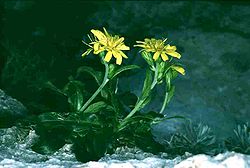| Hieracium lucidum | |
|---|---|
 | |
| Scientific classification | |
| Kingdom: | Plantae |
| Clade: | Tracheophytes |
| Clade: | Angiosperms |
| Clade: | Eudicots |
| Clade: | Asterids |
| Order: | Asterales |
| Family: | Asteraceae |
| Genus: | Hieracium |
| Species: | H. lucidum |
| Binomial name | |
| Hieracium lucidum | |

Hieracium lucidum, or Sicilian sparviere, [2] is a flowering plant in the family Asteraceae. It is very similar to Hieracium cophanense . Hieracium lucidum is a perennial herb that prefers the northern slopes of chalky seaside cliffs exposed to wet winds, including sites rich in nitrates from sea bird droppings. Unlike most other hawkweeds, this species reproduces only from seeds. [1]
